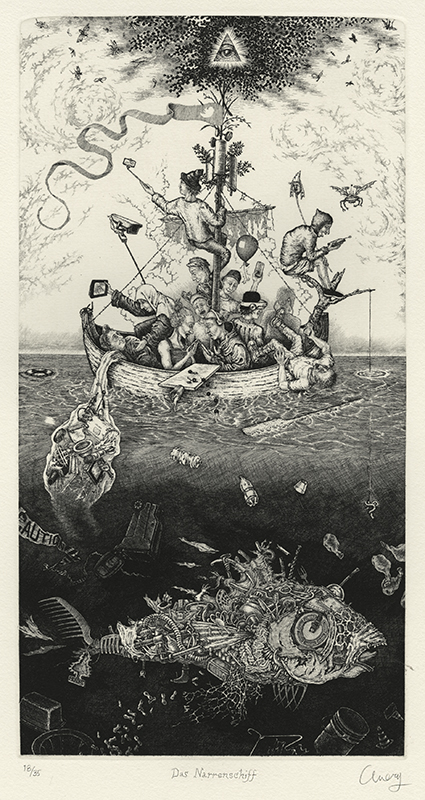Das Narrenschiff is an etching from 2017 by American printmaker David Avery. It is pencil signed, titled and editioned 13/35. It was printed by the artist on Hahnemühle Copperplate Warm White wove and the platemark measures 14-3/8 x 7-1/2inches.
Avery commented on this etching:
Das Narrenschiff was inspired by the renowned painting Ship of Fools by Hieronymus Bosch, who in turn was probably influenced by Sebastian Brandt’s 15th century litany of follies in verse (112 to be exact) titled Das Narrenschiff. The medieval Ship of Fools trope tapped into by Brandt has roots probably originating in an excerpt from Book VI in Plato’s Republic. Modern concerns combined with indiscriminate anachronism take precedence in this work, where the owl representing heresy which presides over the scene has been replaced by the symbol of the Almighty Dollar, and the Twitter logo has insinuated itself in the flag where the Muslim Crescent (more heresy!) once resided. Cherries and a silver cup, which represented lust in the Bosch painting, are falling off the table as the passengers in various states of dress, modern or not, fall deeper into their mobile devices, and further from the consequences of their actions in the actual world. At this point, everyone should be beginning to wonder what that taste is when they bite into their next tuna sandwich.
Das Narrenschiff is a hard ground line etching on copper, realized using traditional methods. A polished copper plate is covered with a thin ground of wax, which is drawn through with an etching needle. When immersed in the etchant (ferric chloride), an indentation is eaten away where the metal has been exposed, creating a line that will hold the ink. Subsequent drawing and immersions will create lines of different values, the darker lines having been etched longer. Each state of the print involved up to 16 separate etches, and this etching took five states to complete.
As to his creative output, Avery’s own words anticipate the questions of the viewer: “Where do my ideas come from? The same place as everyone else’s—the brain. Or more precisely, they come from the interaction between experience and imagination that takes place within the brain, and I tend to think of my discovery of images in terms of receptivity rather than inspiration or creativity. If anything, my intent in pursuing a carefully worked out and highly detailed image is to work towards an inward goal unbounded by a set beginning or end, rather than trying to make some inner vision tangible. Even a simple nursery rhyme, once you start picking at it, will reveal layer upon layer of associations and further meanings. I consider my work successful to the extent that it continues to generate multiple interpretations, releasing this capacity for receptivity to the mysterious and the ambivalent that reflects the essential vibrancy of life.”
David Avery, born 4 February 1952, has been creating finely detailed black and white etchings in San Francisco for over thirty years. Originally trained as a classical musician, Avery discovered etching almost by accident in a class at a local community college. After learning the basic techniques, he intently pursued his own course of discovery, being essentially self-taught. Over the years, he has developed an exceptional technique and has created a remarkable body of finely wrought miniature etchings and drypoints. He prefers printing in black and white finding the subtleties and tonalities most capable of creating the psychological mood that allows his work to be effective.
Avery has a long and active exhibition history and his prints have earned him numerous awards and honors. He has been a member of and exhibited with the California Society of Printmakers, the Washington Printmakers, and the Society of American Graphic Artists. His works are represented in the collections of the Fogg Museum, Harvard University, Cambridge, Massachusetts; the Turner Print Museum, California State University, Chico, California; the Nelson-Atkins Museum of Art, Kansas City, Missouri; the New York Public Library, New York; the Fine Arts Museums of San Francisco, California; Stanford University Library, Special Collections, Stanford, California; and the Folger Shakespeare Library and the Library of Congress, Washington, D.C.



